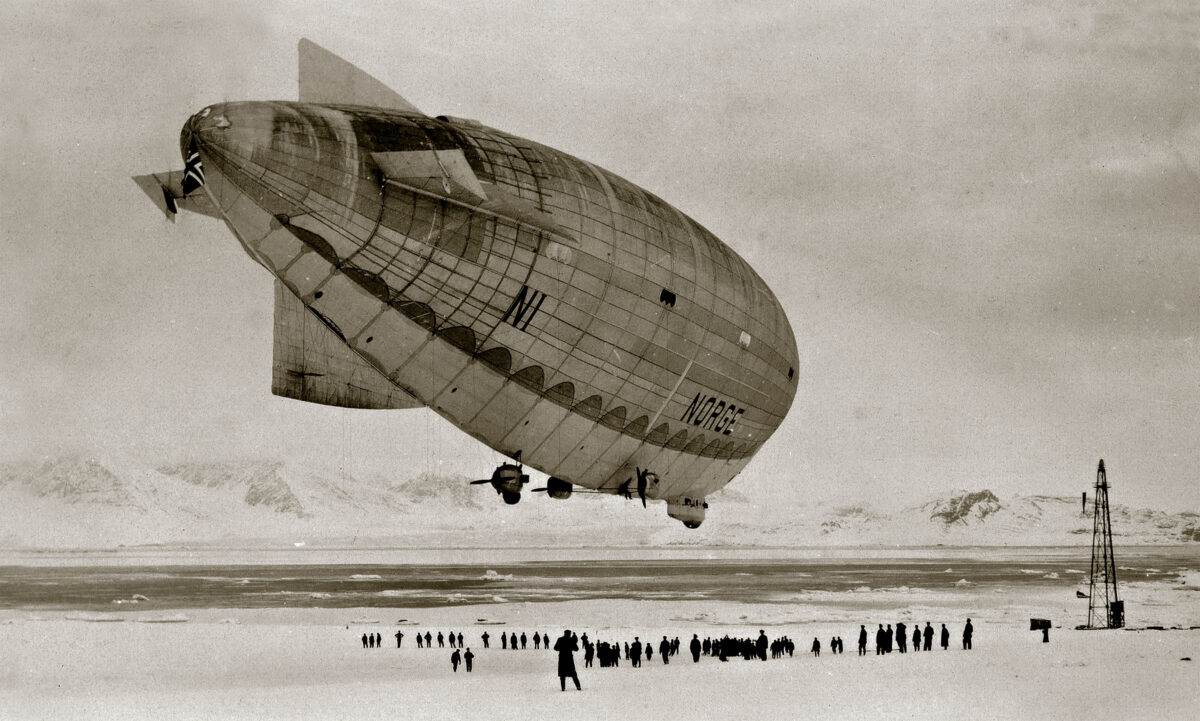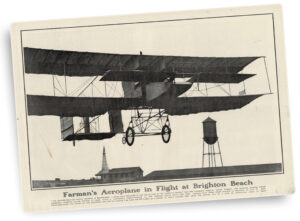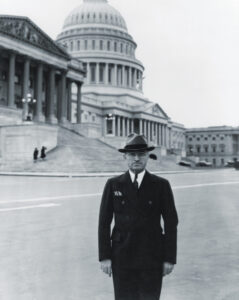On Front Street, outside City Hall, a bronze bust of Nome’s most famous visitor, explorer Roald Engelbregt Gravning Amundsen, greets tourists and fellow adventurers—mushers at the Iditarod Trail Sled Dog Race’s finish line. The beak-nosed old salt looks a bit green around the gills, and gulls sometimes treat him unkindly. He deserves better.
Amundsen last set foot in this town at 5 a.m. on May 16, 1926, in the company of four men, delivered to shore by the launch Pippin. He had departed Ny-Ålesund, Norway, on Spitsbergen’s westernmost tip five days earlier aboard the semi-rigid airship Norge with 15 others bound for the North Pole. Norge, named after Amundsen’s homeland, had departed Rome on March 29 and journeyed to Svalbard’s Norwegian-ruled islands via London and Leningrad. The silver-cigar hulk, dull pewter when clouds shuttered the sun, was the brainchild of Colonel Umberto Nobile, an aeronautical engineer and World War I Italian air service officer whose bearing befitted his last name. With its 347-foot-long rubberized membrane braced by a metal frame fore and aft and plumped by 670,000 cubic feet of pressurized hydrogen—the equivalent of more than seven Olympic-size pools—Norge was no mere blimp, no manatee. The airship could travel at 62 mph, half the top speed of that era’s fastest racecars.
With Nobile as pilot, Amundsen as the expedition leader and Lincoln Ellsworth, the American sponsor-sportsman son of a millionaire, Norge cast off at 8:55 a.m. on May 11 to make history.
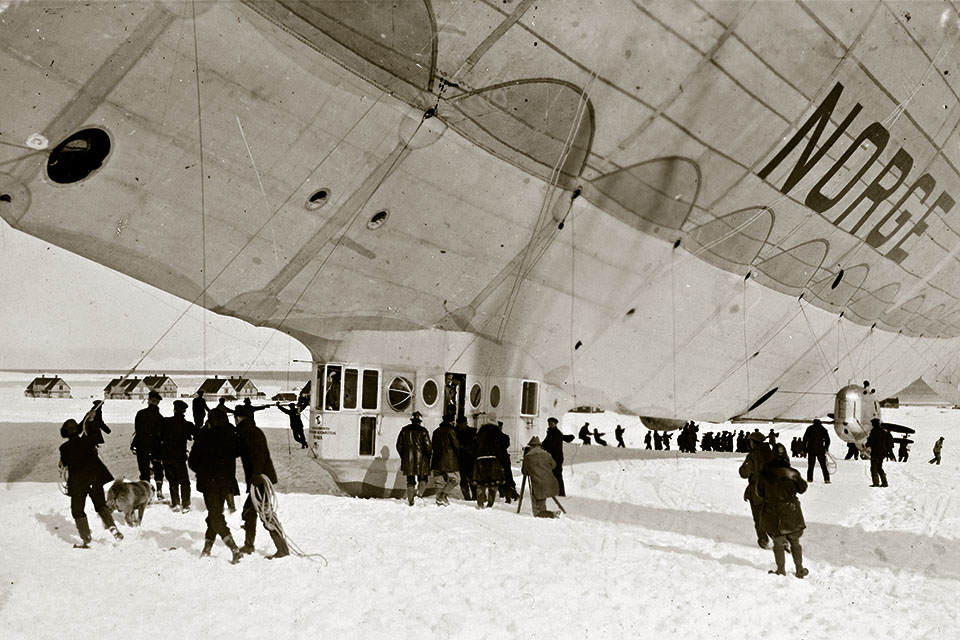
It was smooth sailing at 3,000 feet. Ink-black water gaped in the fanged pack ice below. Polar bears startled by the monstrous apparition dove into the sea, belugas hid under floes. Near the magnetic pole, Norge’s compass twitched nervously.
The scene transported Amundsen back to 1906, when he and his crew of six had sailed the sloop Gjøa through the long-sought Northwest Passage between Greenland and Alaska. Jailed by ice and “wild with eagerness to get to a telegraph office and send the news to the world,” he’d sledded from Herschel Island to the city of Eagle, Alaska, 700 miles round trip, his quest all but completed. Having found his stride, he’d then led the first group to the South Pole in 1911.
At 6 p.m., Norge’s port engine stalled. The switch to the third, starboard engine—silenced thus far to save fuel and as a reserve—went smoothly. It started with a roar and the mechanic attending the dead one, cussing for hours, found the glitch: Ice had clogged the fuel line.
At midnight, Ellsworth turned 46. Ninety minutes later, on May 12—16 hours after leaving Ny-Ålesund—Norge’s shadow fell on the pole, as sextant readings confirmed. The crew dropped three weighted flags from a window: Norway’s indigo, white-bordered cross on a red field; Italy’s Tricolore; and Old Glory, a nod to Ellsworth funding the venture. They relished their single hot meal: meatballs from a thermos cask, swimming in grease. Their hydrogen gas and engine fuel cargo made cooking and smoking too risky.
Norge, sniffing safety, pointed its blunt muzzle south, toward Alaska.
Alas, conditions deteriorated inside and out. Relations between Amundsen and Nobile, already strained in the cramped, freezing, noisy cockpit, worsened when the Norwegian noticed that the Italian flag fluttering pole-ward was bigger than the other two.
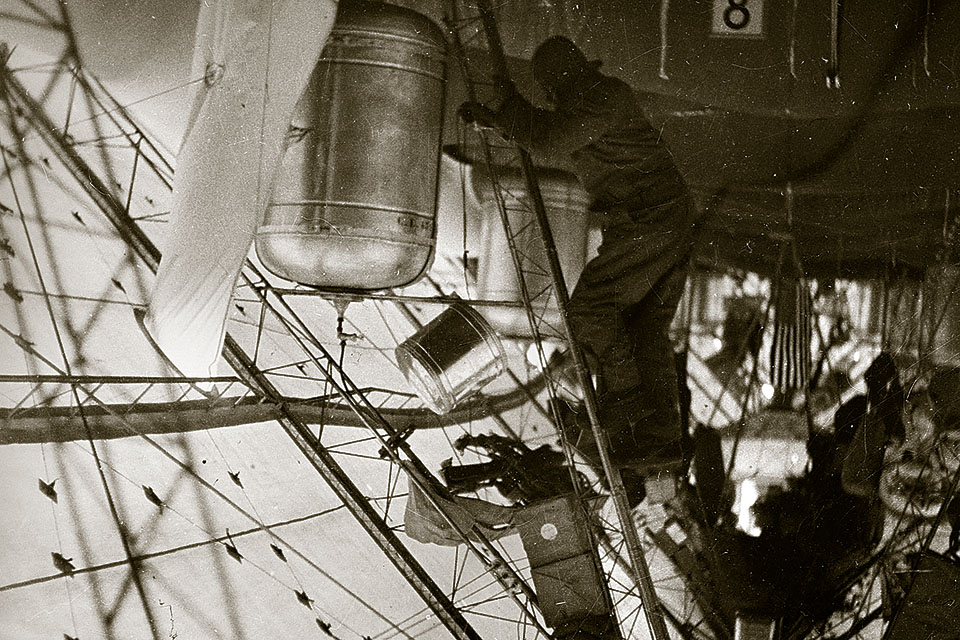
Since that milestone, ice had sheathed Norge’s exterior guide wires. As vibrations flaked off shards, the propellers hurled them against the behemoth’s fabric, where, sounding like gunshots, they tore ragged cuts. The sleep-deprived crew rubber-patched several. Under the mental strain and pelted by snow—as if in a disaster flick in which things progressively fall apart—they imagined seeing the mainland.
First land materialized west of Barrow at 6:45 a.m. on the 13th. Norge droned over the whaling community of Wainwright a little later. Amundsen and his engineer, Oskar Omdal, recognized a cabin in which they’d stayed during the 1922-23 Maud Expedition. Through snow-streaked windows, they saw figures on the roof of the small house waving at them.
Near Teller, Norge followed a ravine amid the landscape’s milky monotony. Without warning, a blast of wind pushed the airship toward a flanking hill. The windows had fogged up, so Nobile, taking over the wheel, ordered the navigator to stick his head out. A warning of impending doom came almost too late. Nobile, pulling into a steep climb, managed to dodge the hill but feared he’d lost an engine gondola. The engineer in that pod swore he could have touched the rocky crest.
Next, the sun caused the hydrogen to expand, lifting Norge like a child’s runaway Mylar balloon. The increasing pressure threatened to burst Amundsen’s bubble. Nobile opened valves to bleed the envelope. The airship, however, rose faster than gas could be released. “Fast to the bow” sent crew members scrambling up the tilted keel, shifting the balance. Norge’s nose dropped, ending the deadly climb seconds before the gasbag would have ripped.
At 3:30 a.m. on May 14, Norge reached Teller, an Inupiaq-Eskimo coastal settlement 63 miles northwest of Nome. Residents spotting the airship from their windows first mistook it for an odd cloud in the shape of a whale. Amundsen chose to end the flight here, 3,393 miles from Ny-Ålesund. They’d been awake more or less for three days, fueled by coffee and sandwiches, though with subzero temperatures the coffee was cold and the sandwiches brittle shingles.
All 100-some villagers crowded onto the sea ice, including 14-year-old Elizabeth “Betty” Pinson, who’d lost both legs to frostbite at age six when the 1918 influenza pandemic killed the grandparents whom she’d been visiting in their sod igloo. (Kind-hearted folks had ordered and paid for prosthetics.) The kids around Betty clung to each other or to their mothers or clapped hands over their ears to drown out the racket. Some hid in closets, thinking the world was about to end. Most of the assembled Inupiaq only even knew cars from pictures.
A voice from up high—Amundsen’s boosted by megaphone—announced the imminent descent, whereupon one storeowner grabbed the bowline and headed Norge into the wind. The airship hoisted several people off their feet, bucking, reluctant to conclude its voyage.
The two men who emerged from Norge’s belly couldn’t have been less alike. Nobile—in full uniform, with medals, jackboots polished, slender, dark-eyed, clean-shaven—cradled his terrier Titina, an adopted orphan that hated flying and trembled despite her wool jersey. Amundsen may have disembarked first, in a ratty old parka and earflap hat, unsmiling as ever, the irises above his gray handlebar mustache blue as the ice of which he had seen so much. In fact, to coordinate the mooring, the mechanic Ettore Arduino already had parachuted in, mistaken by Betty for a falling door. His two superiors were no longer on speaking terms and would bunk separately with their crews in the two local stores’ dorms.
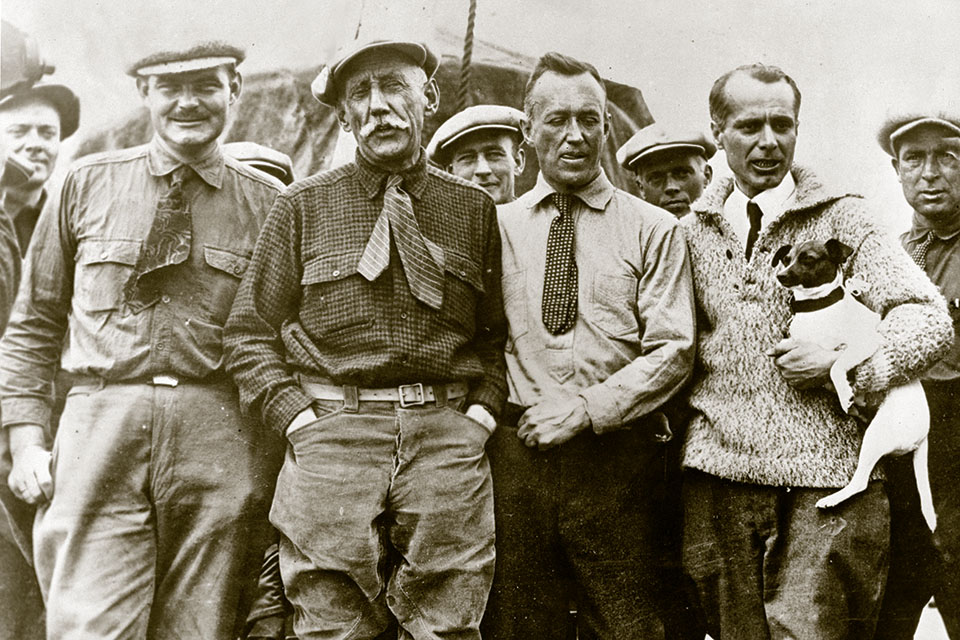
Still, Amundsen probably felt like the “Three Lucky Swedes” who’d unleashed Nome’s gold rush (one of whom actually was Norwegian).
Nobile ordered Norge’s gasbag to be deflated by pulling the release cords right away, to avoid damage. A gust nevertheless rolled the airship, which to Betty sounded “as if a million tin cans were rattling around inside.”
The crew handed out cookies, candy and Italian oranges. “It was like Christmas all over again,” Betty remembered. Amundsen, this time spared a 700-mile slog, used a small radio in the village to report their safe landing to Nome.
For weeks afterward, Teller buzzed with news of the handsome European strangers who became friends and romantic interests. And it seemed as if every woman in town wore a blouse or dress of airship silk from the hull.
In Nome, the welcome differed from the one Amundsen had received with Gjøa two decades earlier. Then, he’d paraded through town in a wagon, feted by burghers and boisterous miners, toasted at the Golden Gate Hotel. This time, he’d let them down. Bunting was scrapped, disappointment openly voiced. The reception committee disbanded. Teller, not gale-force winds, in their view had stolen the glory.
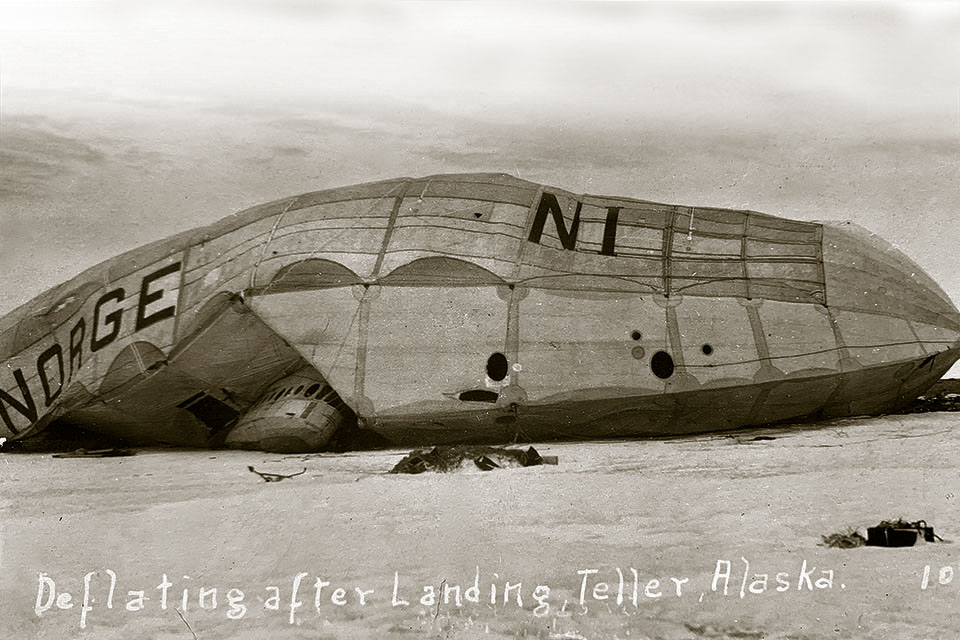
Dismantled by the Italians, Norge’s salvaged parts were crated and stored in a two-story wood-frame building in Teller to await shipment to Seattle. The storage house, listed in the National Register of Historic Places, still stands.
Nobile was promoted to general and hailed for his “conquest” as a hero of Benito Mussolini’s fascist state. In 1928, two years after they landed in Teller, seeking fame for himself and his country exclusively, he crashed Norge’s sister ship Italia northeast of Spitsbergen, stranding Titina and nine surviving crewmen on the ice.
Putting aside old grudges, Amundsen set out on a rescue mission from Tromsø, Norway, in a Latham 47 flying boat with Norwegian pilot Leif Dietrichson and four Frenchmen…never to return. Except for a wing float and fuel tank off Norway’s coast, no trace of the men or seaplane was ever found. It would take 48 days for all the Italia crash survivors to be rescued.
GET HISTORY’S GREATEST TALES—RIGHT IN YOUR INBOX
Subscribe to our HistoryNet Now! newsletter for the best of the past, delivered every Monday and Thursday.
Discussing dirigibles in 1926, Ellsworth and Amundsen had agreed that in addition to carrying heavier loads and being able to stay airborne longer, airships had other advantages. Airplanes had to land if an engine failed; an airship crew might repair one aloft. And touchdown by plane through fog, on ice, spelled “certain death.”
Perhaps Amundsen sensed that he’d used up all his lives. “If only you knew how splendid it is up there,” he told a journalist in 1928. “That’s where I want to die.”
Nobile, heavily criticized for the Italia flight and disgraced in his native country, continued to work with airships in the Soviet Union.
Amundsen had unmoored Norge at Svalbard just two days after Richard E. Byrd and Floyd Bennett returned from their polar flight in the Fokker F.VIIa/3m trimotor Josephine Ford. Byrd’s claim, like those of Frederick Cook (1908) and Robert Peary (1909), has been disputed. Norge’s accomplishment, the first polar transit from Europe to America, soars beyond doubt.
Michael Engelhard writes from Fairbanks, Alaska, and is the author of Ice Bear: The Cultural History of an Arctic Icon. He was surprised to learn that blue-eyed Elizabeth Pinson, the main source on Norge’s time in Teller, was the daughter of an Inupiaq mother and a shipwrecked German sailor who became a trader there. Additional reading: Alaska’s Daughter: An Eskimo Memoir of the Early Twentieth Century, by Elizabeth Pinson; First Crossing of the Polar Sea, by Roald Amundsen and Lincoln Ellsworth; and My Polar Flights: An Account of the Voyages of the Airships Italia and Norge, by Umberto Nobile.
This feature appeared in the March 2021 issue of Aviation History. To subscribe, click here!

